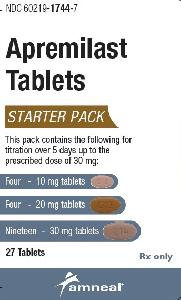Apremilast Dosage
Medically reviewed by Drugs.com. Last updated on Nov 19, 2024.
Applies to the following strengths: 30 mg; 10 mg-20 mg-30 mg; 20 mg; 10 mg-20 mg
Usual Adult Dose for:
Additional dosage information:
Usual Adult Dose for Behcet's Disease
Initial dose titration:
- Day 1: 10 mg orally once a day (AM)
- Day 2: 10 mg orally twice a day (AM and PM)
- Day 3: 10 mg orally once a day (AM) and 20 mg orally once a day (PM)
- Day 4: 20 mg orally twice a day (AM and PM)
- Day 5: 20 mg orally once a day (AM) and 30 mg orally once a day (PM)
Maintenance dose (Day 6 and thereafter): 30 mg orally twice a day (AM and PM)
Comments:
- Dose titration is intended to reduce gastrointestinal symptoms associated with initial treatment.
Uses:
- For the treatment of patients with active psoriatic arthritis
- For the treatment of patients with plaque psoriasis who are candidates for phototherapy or systemic therapy
- For the treatment of patients with oral ulcers associated with Behcet's disease
Usual Adult Dose for Psoriatic Arthritis
Initial dose titration:
- Day 1: 10 mg orally once a day (AM)
- Day 2: 10 mg orally twice a day (AM and PM)
- Day 3: 10 mg orally once a day (AM) and 20 mg orally once a day (PM)
- Day 4: 20 mg orally twice a day (AM and PM)
- Day 5: 20 mg orally once a day (AM) and 30 mg orally once a day (PM)
Maintenance dose (Day 6 and thereafter): 30 mg orally twice a day (AM and PM)
Comments:
- Dose titration is intended to reduce gastrointestinal symptoms associated with initial treatment.
Uses:
- For the treatment of patients with active psoriatic arthritis
- For the treatment of patients with plaque psoriasis who are candidates for phototherapy or systemic therapy
- For the treatment of patients with oral ulcers associated with Behcet's disease
Usual Adult Dose for Plaque Psoriasis
Initial dose titration:
- Day 1: 10 mg orally once a day (AM)
- Day 2: 10 mg orally twice a day (AM and PM)
- Day 3: 10 mg orally once a day (AM) and 20 mg orally once a day (PM)
- Day 4: 20 mg orally twice a day (AM and PM)
- Day 5: 20 mg orally once a day (AM) and 30 mg orally once a day (PM)
Maintenance dose (Day 6 and thereafter): 30 mg orally twice a day (AM and PM)
Comments:
- Dose titration is intended to reduce gastrointestinal symptoms associated with initial treatment.
Uses:
- For the treatment of patients with active psoriatic arthritis
- For the treatment of patients with plaque psoriasis who are candidates for phototherapy or systemic therapy
- For the treatment of patients with oral ulcers associated with Behcet's disease
Renal Dose Adjustments
Mild to moderate renal dysfunction (CrCl 30 to 89 mL/min): No adjustment recommended
Severe renal dysfunction (CrCl less than 30 mL/min): Dose reduction recommended as follows:
- Initial dose titration:
- Days 1 to 3: 10 mg orally once a day
- Days 4 to 5: 20 mg orally once a day
- Maintenance dose (Day 6 and thereafter): 30 mg orally once a day
Liver Dose Adjustments
Moderate to severe liver dysfunction (Child-Pugh B and C): No adjustment recommended
Precautions
CONTRAINDICATIONS:
- Known hypersensitivity to the active component or to any of the ingredients
Safety and efficacy have not been established in patients younger than 18 years.
Consult WARNINGS section for additional precautions.
Dialysis
Data not available
Other Comments
Administration advice:
- For oral use
- Dose(s) may be administered without regard to meals.
- Do not split, crush, or chew tablets.
Storage requirements:
- Store below 30C (86F).
Monitoring:
- Gastrointestinal: For signs/symptoms of severe diarrhea, nausea, or vomiting, especially in patients 65 years or older (during treatment)
- General: For weight loss (regularly during treatment)
- Psychiatric: For depression, suicidal thoughts, or mood changes (at baseline and during treatment)
Patient advice:
- Inform your health care provider if psychiatric changes occur, including new or worsening of depression, suicidal thoughts, or other mood changes.
- Contact your health care provider if you experience adverse gastrointestinal reactions, especially if you are 65 years or older.
- Notify health your care provider regarding any symptoms of an allergic reaction after taking this drug.
- Inform your health care provider of significant or unexplained weight loss; monitor weight regularly.
- Tell your healthcare provider about all of the medicines and supplements you take.
- Pregnant patients or women of childbearing potential: Alert your health care provider of a known/suspected pregnancy.
Frequently asked questions
- Sotyktu vs Otezla: How do they compare?
- How long does it take for Otezla to work?
- Who makes Otezla and why is it so expensive?
- How does Otezla work and what's its MOA?
- What are the new drugs for plaque psoriasis?
- Is Otezla (apremilast) an immunosuppressant?
More about apremilast
- Check interactions
- Compare alternatives
- Reviews (478)
- Drug images
- Side effects
- Patient tips
- During pregnancy
- Drug class: antirheumatics
- Breastfeeding
- En español
Patient resources
Other brands
Professional resources
Other brands
Related treatment guides
See also:
Further information
Always consult your healthcare provider to ensure the information displayed on this page applies to your personal circumstances.


